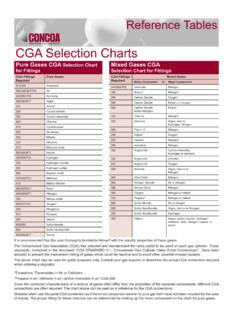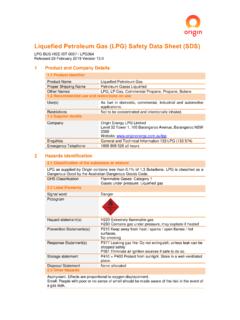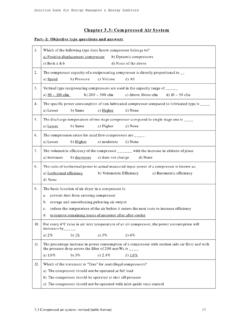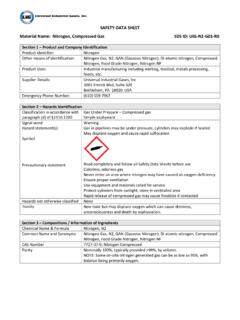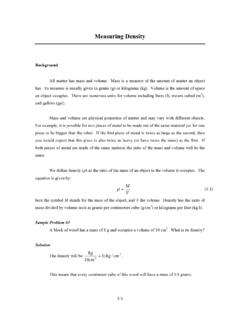Transcription of IC ENGINE TERMINOLOGY - RAJESH RAMAKRISHNAN
1 IC ENGINE TERMINOLOGY : The following terms/Nomenclature associated with an ENGINE are explained for the better understanding of the working principle of the IC engines. 1. Bore: The nominal inside diameter of the ENGINE cylinder is called bore. 2. Top Dead Centre (TDC): The extreme position of the piston at the top of the cylinder of the vertical ENGINE is called top dead centre (TDC), Incase of horizontal engines. It is known as inner dead centre (IDC). 3. Bottom Dead Centre (BDC): The extreme position of the piston at the bottom of the cylinder of the vertical ENGINE called bottom dead centre (BDC). In case of horizontal engines, it is known as outer dead center (ODC). 4. Stroke: The distance travelled by the piston from TDC to BDC is called stroke. In other words, the maximum distance travelled by the piston in the cylinder in one direction is known as stroke. It is equal to twice the radius of the crank. 5. Clearance Volume (Vc): The volume contained in the cylinder above the top of the piston, when the piston is at top dead centre is called the clearance volume.
2 6. Swept Volume (Vs): The volume swept by the piston during one stroke is called the swept volume or piston displacement. Swept volume is the volume covered by the piston while moving from TDC. to BDC. 2. Swept volume = Vs = AxL= D L. 4. where A = Cross sectional area of the piston in , L = Stroke in m, and D = cylinder bore , inner diameter of the cylinder in m. 7. Compression Ratio (rc): Compression ratio is a ratio of the volume when the piston is at bottom dead centre to the volume when the piston is at top dead centre. Mathematically, MaximumCylinderVolume Compression ratio =. MinimumCylinderVolume SweptVolume + ClearenceVolume =. ClearenceVolume The compression ratio varies from 5 : 1 to 10 : I for petrol engines and from 12:1. to 22 : I for diesel engines. Classification Criteria Types 1. No of Strokes per cycle 1. Four Stroke ENGINE 2. Two Stroke ENGINE 2. Types of Fuel Used 1. Petrol or Gasoline ENGINE 2. Diesel ENGINE 3. Gas ENGINE 4. Bi-Fuel ENGINE 3.
3 Nature of Thermodynamic 1. Otto Cycle ENGINE Cycle 2. Diesel Cycle ENGINE 3. Dual Combustion Cycle ENGINE 4. Method of Ignition 1. Spark Ignition (SI) ENGINE 2. Compression Ignition (CI) ENGINE 5. No of Cylinders 1. Single cylinder ENGINE 2. Multi cylinder ENGINE 6. Arrangement of Cylinders 1. Horizontal ENGINE 2. Vertical ENGINE 3. V Type ENGINE 4. Radial ENGINE 5. Inline ENGINE 6. Opposed cylinder ENGINE 7. Opposed Piston ENGINE 7. Cooling System 1. Air Cooled ENGINE 2. Water Cooled ENGINE 8. Lubrication System 1. Wet Sump Lubrication System 2. Dry Sump Lubrication System 9. Speed of the ENGINE . 1. Slow Speed ENGINE 2. Medium Speed ENGINE 3. High Speed ENGINE 10. Location of Valves 1. Over Head Valve ENGINE 2. Side Valve ENGINE CONSTRUCTION & COMPONENTS OF IC ENGINE : 1. cylinder Block: It is the heart of the ENGINE . It consists of three parts. (i) The cylinders in which the piston slides up and down. (ii) The ports or openings for valves. (iii) The passages (water jackets) for the flow of cooling water.
4 Function: In the bore of the cylinder , the charge is compressed by piston, ignited and expanded to give power to piston. Material: Aluminium alloy and grey cast iron. 2. cylinder Head: It is fitted on the top of the cylinder . It has inlet valve, exhaust valve and the spark plug or fuel injector. Function: Through inlet valve fresh charge is admitted and through exhaust valve burnt gases are send out Material: Grey cast iron, Aluminium alloy and cast steel. 3. Piston: It is the main active part of the ENGINE . It is cylindrical in construction and slides tip and down inside the cylinder . It has piston rings to provide good seal between the cylinder wall and the piston. There are three grooves to accommodate piston rings. Function: (i) To compress the fresh charge during the compression stroke. (ii) To transmit the force exerted due to combustion of the charge to the connecting rod finally to the crankshaft during the power stroke. Material: Aluminium alloy cast steel, cast iron and chrome nickel 4.
5 Combustion Chamber: The space enclosed in the upper part of the cylinder , by the cylinder head and the piston top during the combustion process, is called the combustion chamber. Combustion chamber is the closed space in which combustion of fuel takes place. 5. Inlet and Exhaust Valves: There are two valves in the cylinder of IC engines inlet and exhaust valve The inlet valve is located at the junction of intake port and cylinder . The exhaust valve is located at the junction of exhaust port and cylinder . Function: (i) Inlet valve allows the fresh charge into the cylinder . (ii) Exhaust valve provides passages for the burnt gases to escape from the cylinder . Material: Inlet valve is made of nickel chromium steel Exhaust valve is made of silchrome steel. 6. Inlet and Exhaust Manifolds: The pipe through which air or air fuel mixture is drawn into the cylinder is called the inlet manifold. The pipe through which the flue gases ( , exhaust gases) escape into the atmosphere is called the exhaust manifold.
6 7. Piston Rings: Piston rings are fitted into the grooves of the piston to maintain good seal between the piston and the cylinder walls. There are two types of pistons rings. Upper rings are called compression rings and the lower rings are called oil rings. Function: Compression rings are used to provide gas tight sealing to prevent leakage of the lubricating oil into the ENGINE cylinder . The oil rings, also called as scrapper rings are used to scrap the used lubricating oil into the crank case. Material: Alloy cast iron containing silicon, manganese, alloy steels, etc. 8. Connecting Rod: The connecting rod interconnects the piston to the crankshaft. The upper end of the connecting rod is fitted to the piston and lower end to the crankshaft. Function: (i) It transmits the power produced in the cylinder to the crankshaft. (ii) It converts the reciprocating motion of the piston into rotary motion of tile crankshaft. Material: Medium carbon steel and alloy steel.
7 9. Piston Pin: The piston pin is a pin that connects the small end of the connecting rod to the piston. It is also known as gudgeon pin or wristpin. 10. Crank Pin: Crank pin connects the connecting rod big end to the crankshaft 11. Crank and Crankshaft: The crank is a lever that is connected to the end of the connecting rod by a pin joint with its other end connected rigidly to a shaft, called crankshaft. The crankshaft is the principle rotating part of the ENGINE . The crankshaft is provided with suitable holes to help in the lubrication system. Function: It converts the reciprocating motion of the piston into useful rotary motion of the Output Shaft. Material: Forged steel. 12. Camshaft: A camshaft is a shaft on which cams are mounted. The camshaft is driven by crankshaft through timing gears. This shaft also provides the drive to the ignition system. Function: It is used to operate the intake and exhaust valves through cam follower, push rod and rocker arm.
8 Material: Forged steel. 13. Cams: Cams are integral parts of the camshaft. Function: Cams are designed in such a way to open the valves at the correct timing and to keep them open for the necessary duration. 14. Flywheel: The flywheel is a heavy wheel that is connected to the extreme end of the crankshaft. The size of the flywheel depends upon the number of cylinders and the general construction of the ENGINE . Function: The flywheel stores the excess energy during the power stroke of the ENGINE and supply the energy for the movement of the piston during the remaining stroke. Thus its function is to maintain Uniform rotation of the crankshaft. Material: Cast iron. Use of Flywheel: The net torque exerted to the crankshaft during one complete cycle of operation of the ENGINE fluctuates causing a change in the angular velocity of the shaft. In order to achieve a uniform torque an inertia mass in the form of wheel is attached to the output shaft and this wheel is called the flywheel.
9 A single cylinder ENGINE will have a larger flywheel whereas a multi cylinder ENGINE will have a smaller flywheel. This is due to the reason that the variation of net torque decreases with increase in the number of cylinders in the ENGINE and thereby the size of the flywheel also becomes smaller. 15. Crankcase: It is a cast iron case, which holds the cylinder and the crankshaft. It also serves as sump for the lubricating oil. Material: Cast iron and Aluminium alloy. TWO STROKE ENGINES. Two stroke engines perform only two strokes to complete one cycle. In a four stroke cycle, the power is obtained only once in two revolutions of the crankshaft. Therefore, much attention was paid to obtain power once in every revolution of the crankshaft and this lead to the development of a two stroke cycle. Two stroke Cycle engines will theoretically give twice the power obtained from a four stroke cycle ENGINE of similar size. Construction: The two stroke IC ENGINE is similar in construction to the four stroke IC.
10 ENGINE except that the valves are replaced by ports, The two stroke engines are provided with Inlet port ports or openings cut in the cylinder walls. The closing and opening of the ports are controlled by the movement of piston. Inlet port is provided to feed the fresh charge into the crankcase. A transfer port is provided to take the compressed charge from the crankcase to the cylinder . The burnt waste gases are discharged into the atmosphere through a exhaust port. The crown of the piston ( , top of the piston) is shaped in such a way to assist in deflecting the fresh charge upwards in the cylinder and help scavenging. Scavenging: Scavenging is the process of forcing out the burnt exhaust gases from the cylinder by admitting the fresh charge into the cylinder . TWO STROKE DIESEL ENGINE . The working principle of a two stroke diesel ENGINE is shown in the Fig. For every one revolution of Crankshaft there is One Power Stroke 1. First Stroke (Upward Stroke of the Piston).
